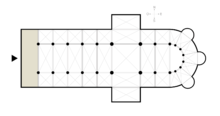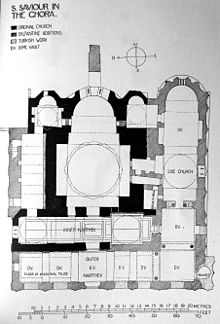Narthex
This articleneeds additional citations forverification.(August 2023) |


Thenarthexis an architectural element typical ofearly ChristianandByzantinebasilicasandchurchesconsisting of the entrance orvestibule,located at the west end of thenave,opposite the church's mainaltar.[1]Traditionally the narthex was a part of the church building, but was not considered part of the church proper.
In early Christian churches the narthex was often divided into two distinct parts: an esonarthex (inner narthex) between the west wall and the body of the church proper, separated from the nave andaislesby a wall,arcade,colonnade,screen, or rail, and an external closed space, the exonarthex (outer narthex),[2]a court in front of the churchfacadedelimited on all sides by a colonnade as in the firstSt. Peter's BasilicainRomeor in theBasilica of Sant'AmbrogioinMilan.The exonarthex may have been either open or enclosed with a door leading to the outside, as in theByzantineChora Church.[3]
By extension, the narthex can also denote a covered porch or entrance to a building.
Etymology
[edit]The original meaning of theClassical Greekwordnarthexνάρθηξ[4]was "giant fennel". Derived meanings are from the use of the fennel stalk asthyrsus,as a schoolmaster's cane, as asinglestickfor military exercise, or as a splint for a broken limb. The term was also used for a casket for unguents, and hence as the title of a number of medical works. Use for the architectural feature of church building is medieval (Byzantine Greek), in use by the 12th century (Etymologicum Magnum). English use dates from the 1670s. It isn't clear how this meaning was derived, allegedly from a resemblance of the entrance area of the church to a hollow stem. InModern Greeknarthekas(νάρθηκας) no longer has the classical meaning and is either the porch of a church, as English, or the brace of a sprained wrist or sling of a broken arm.
In English the narthex is now the porch outside the church at thewest end;formerly it was a part of the church building itself,[5] albeit not considered part of the church proper, used as the place forpenitents.[6]
Purpose
[edit]The purpose of the narthex was to allow those not eligible for admittance into the general congregation (particularlycatechumensandpenitents) to hear and partake of the service. The narthex would often include abaptismal fontso that infants or adults could be baptized there before entering the nave, and to remind other believers of their baptisms as they gathered to worship. The narthex is thus traditionally a place of penitence, and inEastern Christianitysome penitential services, such as theLittle HoursduringHoly Weekare celebrated there, rather than in the main body of the church. In theRussian Orthodox Churchfunerals are traditionally held in the narthex.
Later reforms removed the requirement to exclude people from services who were not full members of the congregation, which in some traditions obviated the narthex. Church architects continued, however, to build a room before the entrance of the nave. This room could be called an insidevestibule(if it is architecturally part of the nave structure) or a porch (if it is a distinct, external structure). Some traditions still call this area the narthex as it represents the point of entry into the church, even if everyone is admitted to the nave itself.
In theEastern Orthodox Church,the esonarthex and exonarthex had, and still have, distinct liturgical functions. For instance, the procession at thePaschal Vigilwill end up at the exonarthex for the reading of the ResurrectionGospel,while certain penitential services are traditionally chanted in the esonarthex.
In some Eastern Orthodoxtemples,the narthex will be referred to as thetrapeza(refectory), because in ancient times, tables would be set up there after theDivine Liturgyfor the faithful to eat a common meal, similar to theagape feastof theearly church.To this day, this is where the faithful will bring theirbasketsatPascha(Easter) for the priest to bless the Paschal foods which they will then take back to their homes for the festivebreak-fast.Traditionally, the narthex is wherecandlesandprosphorawill be sold for offering duringDivine Services.
The doorway leading from the narthex to the nave is sometimes referred to as the "Royal Doors",[7]because in major cathedrals (catholica) there were several sets of doors leading into the nave, the central one being reserved only for the use of theByzantine emperor.[8]
Onfeast daysthere will be aprocessionto the narthex, followed by intercessory prayers, called theLitiy.
InArmeniathe local style of narthex is known as agavit.
-
In the narthex of a small Orthodox church in Romania, looking through the doorway into thenaveandHoly Doors.
-
Side view of a narthex in anEastern Orthodoxtemple. In the center is ananalogionat which the priest hearsconfessions,to the right of that is a silverbaptismal fontand vessels for dispensingholy water.The main hall is to the left (Pechersky Ascension Monastery,Nizhny Novgorod).
See also
[edit]- Antechamber
- Babinets (architecture)
- Cathedral diagram
- Liturgical east and west
- Lobby
- Scarsella
- Westwork
References
[edit]- ^By convention, ecclesiastical floor plans are shown map-fashion, with north to the top and the liturgical east to the right. Therefore, some may refer to the narthex as being at the western end of the floor plan. This is done for symbolic reasons, as scriptures say to look forChristappearing in the east, thus the location of the altar is known as the liturgical east, regardless of the actualcardinal directions.
- ^In other languages a different terminology can arise confusion. For example, in Italian the inner narthex is calledendonarteceand the outer narthexesonartece,as the inner narthex in English. Krautheimer (1986),passim
- ^"narthex".Encyclopædia Britannica.Retrieved23 April2012.
- ^LSJ narthex
- ^William George ClarkPeloponnesus: notes of study and travel1858 Page 110 "One of the most perple xing words in etymology and application is the word narthex. In modern times it can be applied to the porch outside the church at the west end; in old days it was given to a part of the church itself,..."
- ^The national encyclopædia. ed. John H F. Brabner – 1884 "This space was the narthex or" scourge, "and was for the use of penitents. The name was also extended to the outer court"
- ^Sometimes the term "Royal Doors" is imprecisely applied to theHoly Doors.
- ^SeeEzekiel 44:1–3)
Further reading
[edit]- Krautheimer, Richard(1986).Architettura paleocristiana e bizantina(in Italian). Turin: Einaudi.ISBN88-06-59261-0.
External links
[edit] Media related toNarthexesat Wikimedia Commons
Media related toNarthexesat Wikimedia Commons


